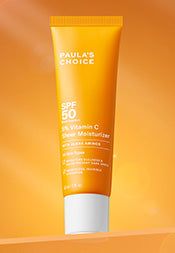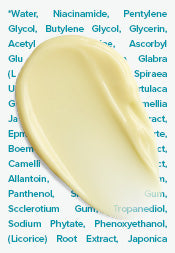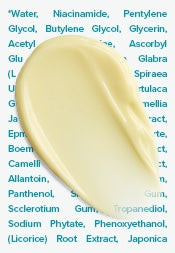What Causes Under Eye Dark Circles?
Dark under eye circles are one of the most common skin concerns. If you’re struggling with them, you’ve likely wondered “why me?” or “how to get rid of the dark circles under my eyes?” We know the feeling, and it got us to research just what causes dark circles and how to reduce them. As it turns out, many things cause or contribute to dark circles under the eyes—some of them may surprise you!
Causes of Under Eye Dark Circles
The major reasons why dark circles show up and persist under the eye area are as follows:
- Sun damage from years of unprotected sun exposure, including indoor tanning, leads to excess pigmentation showing through the thin skin underneath the eyes.
- Blood flow showing through the thin skin around the eye, sometimes referred to as vascular dark circles.
- Using harsh or skin-aggravating ingredients, such as fragrances around the eye area.
- Allergies.
- Inherited traits, where there’s a family tendency to have dark circles around the eyes or just under the eye area.
- Natural shadows, resulting from having deep-set eyes.
- Shadowing from sagging skin and lost facial volume.
- Build up of dry, dehydrated skin around the eyes, causing dullness and a loss of radiance.
- A habit of rubbing eyes, which steadily damages delicate eye-area skin.
Surprisingly, lack of sleep is not a cause of dark circles under the eyes—but failing to get sufficient sleep makes existing darkness look worse, as many of us know all too well.
If you have dark circles under the eyes and have tried to get rid of them, you’ve likely been disappointed by the results — if you saw any improvement at all. Although it’s true that you cannot remove under eye dark circles permanently, there are skincare products and in-office treatments that can make an impressive difference.
How to Reduce Under Eye Dark Circles?
Using gentle, well-formulated skincare products, from a facial cleanser to a leave-on AHA or BHA exfoliant, retinol cream, face serum, and sunscreen for face, along with a well-formulated eye cream, will give you consistent, incremental improvements in the appearance of under eye circles.
In short, a well-formulated skincare routine that includes daily broad-spectrum sun protection with SPF 30 or greater is necessary to improve the look of dark circles. Here’s what else you can do to help visibly reduce dark circles under the eyes:
- Always wear sunglasses outdoors - The delicate skin around the eyes needs more care and protection. As effective as applying sunscreen in the eye area, wearing sunglasses rated to provide 100% UV protection will make a big difference, plus the right pair can look stunning on you.
- Use an over-the-counter antihistamine - Allergies often are an unsuspected cause of or contributor to dark circles and puffy eyes. Consult your healthcare provider for recommendations and follow his or her advice.
- Use a brightening product - A well-formulated skin brightener can help brighten dark circles as it improves the luminosity and vibrancy under the eyes. Look for products such as a vitamin C serum or niacinamide cream (vitamin B3). For even better results, layer multiple brightening products twice daily and top it off with sunscreen during the day.
- Try Azelaic Acid - Higher concentrations of this ingredient can soften the look of dark circles due to sun damage. You can layer an azelaic acid product with those that contain the brightening ingredients listed above; in fact, doing so may lead to more dramatic results, especially for very dark circles. Apply once or twice daily to the under eye area.
- Find a great concealer - Concealers with a soft matte or satin finish are the best because they tend to last longer and don’t crease.
What in-office treatments are available? Research has shown several options that have promise, although most require more than one treatment to get the best results. Intense pulsed light (IPL), radiofrequency, Q-switched ruby lasers, pulsed dye lasers, and ablative lasers (which have the biggest risks and longest recovery time) are all worth discussing with your dermatologist.
What else can be done by a doctor? Dermal fillers using hyaluronic acid, fat transfer, and a cosmetic surgery procedure known as blepharoplasty can provide further improvement.
Chemical peels with salicylic acid (BHA) are sometimes used to improve dark circles. When it comes to treating dark circles, these peels are almost always used in combination with other treatments.
All of these treatments address the underlying causes of dark circles or surface discolourations, or they help improve the skin around the eyes, so it becomes smoother, firmer, and tighter. Hitting all three targets, along with a great skincare routine including sunscreen, is the research-proven way to make dark circles look dramatically better.
Learn more about under eye dark circles and how to get rid of dark eye circles here.
Shop Paula’s Choice effective eye care for brighter, younger-looking undereye.
References for this information:
Lasers in Medical Science, December 2016, pages 1783–1787
Skin Research and Technology, August 2016, pages 276–283
Indian Journal of Dermatology, July-August 2016, pages 413–417
Journal of Cutaneous and Aesthetic Surgery, April-June 2016, pages 65–72
The Journal of Clinical and Aesthetic Dermatology, January 2016, pages 49–55
Annals of Brazilian Dermatology, July-August 2015, pages 494–503
Indian Journal of Dermatology, March-April 2014, pages 151–157
Annals of Brazilian Dermatology, January-February 2014, pages 11–25
Dermatologic Surgery, August 2012, pages 1277–1282
Dermatologic Surgery, August 2009, pages 1163–1171











